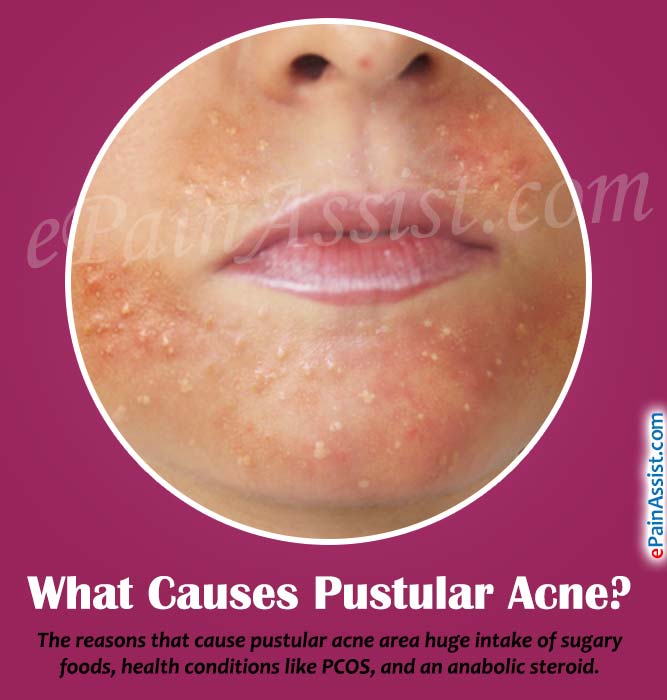There are diverse types of skin break out and one of them is pustular acne. In simple terms, pustular acne is only pimples developing on the face. Pustular acne is a moderate breakout condition.
These repulsive skins break out that grows on the skin when the sebum in hair follicles gets caught due to dead skin cells and dirt. Blockage causes the skin pore to extend and take a shape of bump prompting the development of a pustule. Since pustular acne is terrible in appearance as well as painful it is vital to know how to treat the condition.
Pustular acne most often happens in adolescents as androgen and estrogen hormones are delivered in abundance amid this growth period. They fortify excessive creation of sebum from the sebaceous organs.
What Causes Pustular Acne?
There is no different causative cause for the development of pustular acne. It takes place as some other type of skin breakout. The reasons that cause pustular acne area huge intake of sugary foods, health conditions like PCOS, and an anabolic steroid. Also, the growth hormones such as androgen can be brought into the body from milk and items. It mostly happens to teenagers and especially girls. However, it may grow among people in their twenties too.

The sebaceous glands create an oily skin. This oily substance is called sebum that discloses onto the skin surface through the opening of the follicle, typically called a pore. Keratinocytes cells line the follicle.
Thus, the hair follicles, sebum, and keratinocytes that fill the limited follicle create a plug. Bacteria called Propionibacterium acnes (P. acnes), that regularly live on the skin, grows in the clogged follicles due to the mixing of oil and cells.
Ultimately, these microscopic organisms create chemicals and catalysts and pull in white platelets that give rise to irritation. Irritation or inflammation is a typical cause of tissues to injuries and disease. Hence, when the mass of the stopped follicle separates, it spills everything into the close-by skin—sebum, shed skin cells, and bacteria prompting sores or pimples.
- Pustular acne grows primarily on chin, cheek and around the mouth.
- Pustular acne shows up as moderate size knocks on the face with red inflammation and yellow or white dot in the middle.
- Pustular acne is set to be recognized by four signs: redness, swelling, pain, and heat.
- Pustular acne consists of white, thick liquid made of white cells. This purulent fluid is ordinarily called pus.
- The skin under and around the bumps is red.
Although pus is normally a sign of infection, there is no confirmation that infection is the main reason for pustular acne.
Remedies to Manage Pustular Acne
Moderate pustular acne gets generally retreated of its own in one week. Since pustular acne is terrible in appearance as well as painful it is vital to know how to treat the condition.
- The initial step to take is to change your eating regimen. Reduce consumption of oily sustenance, sugary beverages, and snacks. Also, restrain from milk and milk products to check whether your pustular acne shows signs of improvement without them.
- Adopt basic healthy skin regimen as they can help in cleanup of gentle pustular acne and will not let them grow again. Thus, wash your face at least twice in a day with gentle cleansers and soaps.
- Use moisturizers and lotions that are oil free and probably water based for managing pustular acne.
- Use products that consist of Benzoyl peroxide which is compelling topical antibacterial to eliminate bacteria inside the pores. Salicylic acid opens the pores with the goal that benzyl peroxide can go into the pores and purifies the skin.
- Keep away from impulsively touching the face or picking the pustular acne.
- Try to relax, since stress can also cause skin inflammation and pustular acne.
- MedicalNewsToday. “Pustules: What to know.” https://www.medicalnewstoday.com/articles/322083
- American Osteopathic College of Dermatology. “Acne.” https://www.aocd.org/page/acne
- WebMD. “Understanding Acne — Treatment.” https://www.webmd.com/skin-problems-and-treatments/acne/understanding-acne-treatment
- Mayo Clinic. “Acne.” https://www.mayoclinic.org/diseases-conditions/acne/symptoms-causes/syc-20368047
Also Read:
